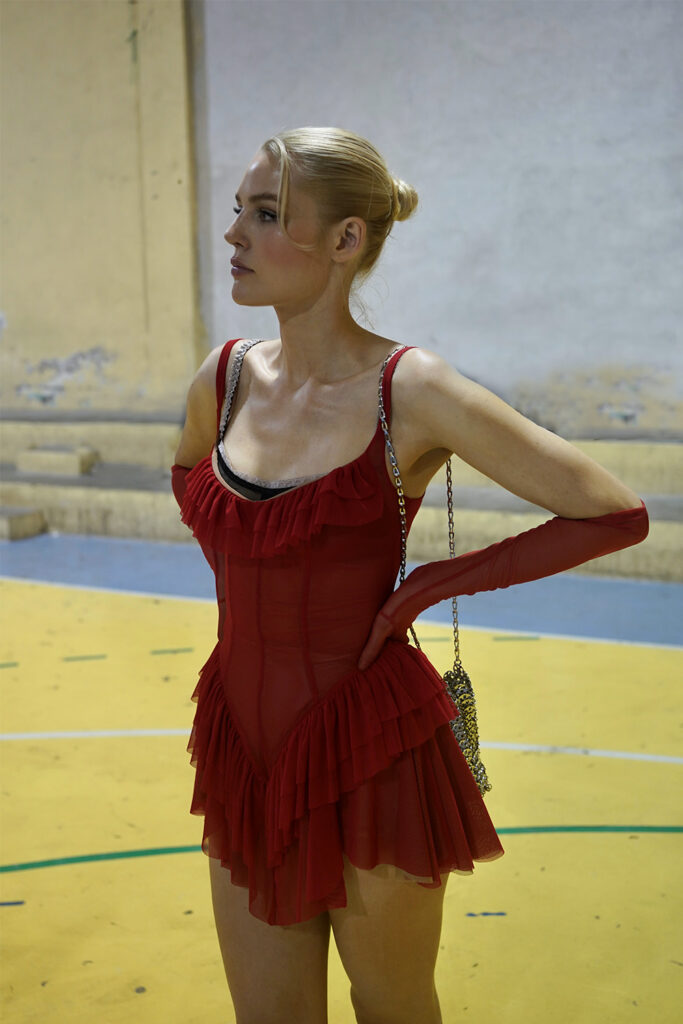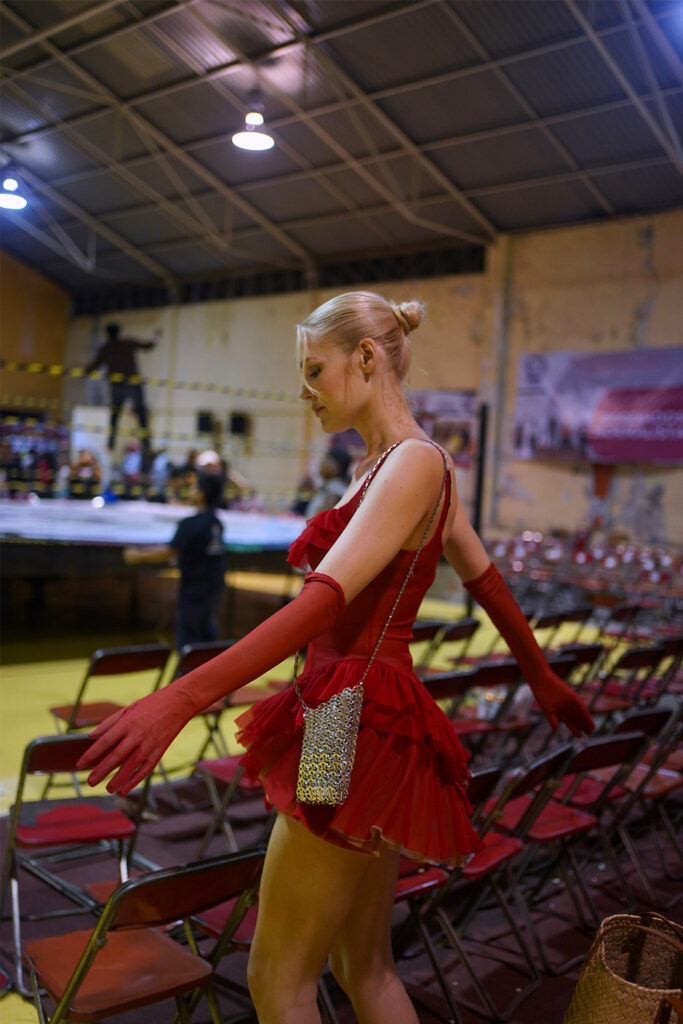When my father moved to Oaxaca a decade ago, I gained a treasured second home. Nestled between two mountain ranges and quite a distance from the beach and Mexico City, more people than ever are finding their way there. I spent the month of April there on a dreamy vacation with my boyfriend, with the fun task of documenting some of the things I wore in various Oaxacan locales. It is a place that almost demands vibrant dress; its artistic spirit and beauty are contagious. Oaxaca is a precious place, a city trying to maintain its integrity without sacrificing the warm welcome visitors find there. What started as a guide to style and beauty — two things I care about deeply—evolved into something a little more in-depth as I interviewed local business owners about the things that make Oaxaca special, and how we can help preserve the magic.
Oaxaca’s beauty hits you immediately. With gorgeously preserved Baroque architecture rooted in the colonial era, and endless artistic, cultural and culinary charms. The city provides another worldliness that is hard to find elsewhere. Cantera volcanic rock makes up the city walls and churches, making them glow greenish-gold at sunset and turn a deep turquoise when it rains. Jacaranda and red flame trees line the dusty pavement with fluorescent tissue paper petals.
Indigenous people make up 48% of the state’s population, and heritage tourism as well as the sales of artisanal products are a huge part of the city’s economy. Locals are heartbreakingly kind and more than willing to put up with your bad Spanish. There is a palpable air of fun and celebration that exists in tandem with the tourism industry but also as a separate intrinsic part of the culture.


Religious, historical and cultural holidays arrive in a never-ending stream; parades, concerts, and celebrations of all kinds. Every couple of days a wedding party can be seen bobbing down the main streets with traditional giant paper mache puppets modelled to look like the bride and groom. “Day of the Dead” is perhaps the best known and most popular among tourists, but there is also Samaritans Day, Guelaguetza and lots of smaller events.
While a huge part of the Oaxacan economy is tourism related there has been a concerted effort by Oaxacan artists and intellectuals to ban big business from taking up space in the heart of the city. In 2003, after a peaceful months-long campaign headed by famous Oaxacan artist Francis Toledo, McDonald’s lost a bid to buy a storefront in the city’s central plaza – called the Zocalo. Toledo, while not against globalization, warns of something he calls “commercialization salvaje” – a reckless disregard for the unique and irreplaceable.
Where to Eat
When it comes to cuisine, Oaxacan food is in a league of its own—a result of both the strong indigenous presence and the extreme biodiversity of the area. The pallet with which chefs paint is rich and varied and usually full of extremely beautiful fresh organic produce. Oaxaca is known for its Mole (traditional sauces), chocolate, chapulines (dried grasshoppers), tejate (a frothy drink) and of course, Mezcal made from the Agave plant. You will have no shortage of restaurants to choose from.
Rodrigo Amaury, a native Oaxacan, owns Nois, a sleek 2 story jazz bar and restaurant in Oaxaca’s Centro. Amaury has worked in various kitchens since he was 17. After a stint in a Michelin-starred restaurant in Spain called Miramar, he opened Nois in Oaxaca in 2018. I thought the name was a reference to music, but Amaury explains that it translates loosely to “guys” or “us”, a reference to the sort of democratic essence of what makes a kitchen work. Nois has a seasonal menu, and while we were there it revolved around fresh seafood from the coast, but it’s always changing. His respect for the traditions of Oaxacan cuisine pushes him to be an innovator. “I’m not going to make mole better than the women in the market, so you aren’t going to see that on the menu.”
Where to Shop
If you want to do some shopping, down the street from Nois is Marchanta, owned by another Oaxacana named Sofia Jiménez Marrufo, a soft-spoken beauty who went to the same high school as Rodrigo. Marchanta sells clothing, pottery and accessories, and houses a small bar and restaurant in its back corner called Bocaflor, featuring some of the best cocktails I’ve had in Oaxaca. I might add that these are very fun to drink while you shop. After high school Jiménez Marrufo went to a prestigious fashion design school in Brazil that allowed her stints in Paris and Japan, and trips to textile factories that provided insight into the supply chain for designer brands. This knowledge has carried over into the curation of her store.

Marchanta just turned 6 years old and is a beautifully designed space with high ceilings and pretty tiled floors. A lot of care has been put into its curation and design. Every object and piece has been picked with extreme care, and it’s clear she is a very talented tastemaker. She has brands and designers from Mexico, Columbia, Peru, France, and India, providing a platform for talented designers that foreigners visiting Oaxaca are unlikely to encounter elsewhere. Sofia got her start very young sewing dresses for Quinceañeras, and eventually started a brand of her own called Arteria; she later shifted away from design in favour of buying and curating for retail, which has become her true passion.
Where to Stay
If you are looking for a place to stay I recommend Casa Antonieta, a gorgeous hotel that opened in 2018, also in the Centro. Edwin López, the hotel’s lovely general manager, gave me some background about the space and its ethos. The building has been passed down through family members, and the hotel’s name is that of the family’s grandmother Maria Antonieta. Design aspects of the hotel are meant to mimic the warmth and femininity of a traditional grandmother’s home. There is a strong scent of bergamot and lavender in the lobby, and the staff is incredibly kind. While there is an extreme level of detail reflected in the ambience and cleanliness of the space, the hotel still feels inviting. There’s a strong sense that the hotel wants guests to feel spoiled and treated warmly like family.


Planning Your Trip
Lastly, if you are in Oaxaca for an extended visit I highly recommend you get Spanish lessons from Bertina Fernandez, another Oaxacana. Born in a small town outside of the city called Juan Copala, Bertina has indigenous roots and speaks Triqui, one of the languages of the Mixtecan family. She moved to the city with her family when she was 10 years old and went on to study languages at University, spending several years in the U.S. to refine her English and then returning to Oaxaca. During Covid, she established her own private Spanish lesson business and built her own school, called ‘Salón de Idiomas Las Lengüitas’. The school currently has three teachers and you can book lessons via WhatsApp.
Unfortunately, alongside the beauty, poverty and struggle remain prevalent in Oaxaca, especially in the small pueblos outside the city. Oaxaca is one of the poorest states in Mexico. The minimum wage in Mexico is roughly 248 pesos a day which translates to about 13$ USD. One of the problems is that with the huge influx of expats and ‘digital nomads’ in Mexico, rent and food prices have risen dramatically. However, I think more and more people want their experience travelling to be beneficial and fair to those they encounter. To endorse and encourage travel to Oaxaca with a clear conscience, it was important to me to talk about tourism with some of the Oaxacans who live and work there. I wanted their opinion on the tourism industry and gentrification, and to find out what we as tourists can do to support them. How can we make the exchange more authentic and respectful?
Amaury takes a pragmatic view, perhaps because his livelihood is very connected to tourism. If he could give any advice to tourists it would be to come to Oaxaca with an open mind. If they want to support the authentic creativity of a place, he says, people should take an interest in not only the traditions but also the innovations locals are making.
Jiménez Marrufo also acknowledges the degree to which her business is supported by tourism but sees
that this exchange has room for improvement on an intellectual and spiritual level. Her advice to tourists is as simple as doing research about Oaxaca before visiting. She suggests finding a way to “be conscious of the place you are visiting” so you don’t fall into tourist traps and can interact with residents on a more meaningful level. And she suggests we strive to “bring something from Oaxaca home”—be that a material thing or something learned.
López suggests that if you are staying in Oaxaca for an extended period, you should find a way to give back to the community. He also raises the issue of climate change. Immigration to Oaxaca is largely unsustainable because of the city’s problems with water supply. He expresses a lot of respect for some of the hotel’s guests who have asked for less frequent room and sheet cleanings during their stay to help conserve water.
Bertina did not mince words. “It has two sides,” she says “because tourism is helping the economy to grow, but that’s only for a few people. A lot of Oaxacans don’t have the skills to take advantage of tourism.” The cost of living has become insane, she says, and locals have found themselves getting pushed out of the centre for a long time now.
Although much of Oaxaca’s tourism is connected to its history and culture, the influx of
tourists can lead to erasures. There is more and more pressure to learn or speak English. And what were once personal holidays have become performative spectacles.
Fernandez cites ‘Day of the Dead’ as an example. What was once a very personal family celebration honouring family members who have passed has now turned into a tourist attraction, blurring the boundaries of what is personal and what is for consumption. If Fernandez could offer some pieces of advice, they would be as follows: do not buy property or start a business in Oaxaca If you are not Oaxacan, look into the customs of Oaxaca and follow them, shop and dine at locally owned businesses and learn Spanish! Something as simple as attempting to speak the language is a sign of respect.
Oaxaca offers a glimpse into the experience of living in a city where its inhabitants’ collective artistic soul is on display every day with shocking sincerity. As modernity surrounds us with soulless conglomerates, where the complex chain of production completely extracts that very soul in question from our products and experiences it is no wonder that people find Oaxaca so intoxicating. But that sincerity comes at a cost and creates a fragility that is worth protecting.
This article has been edited and corrected on July 11th.

